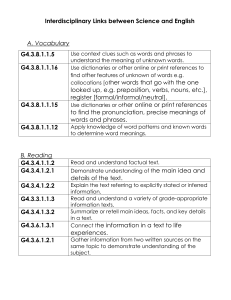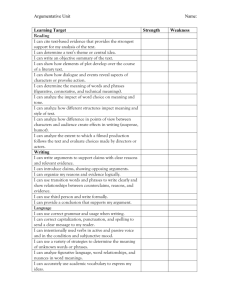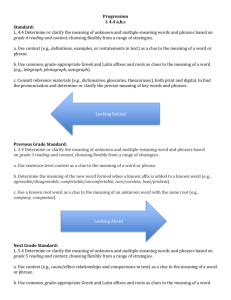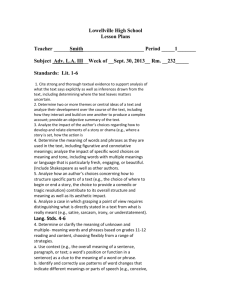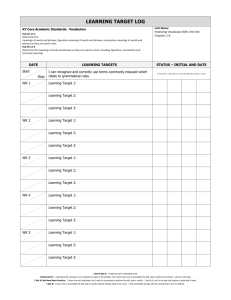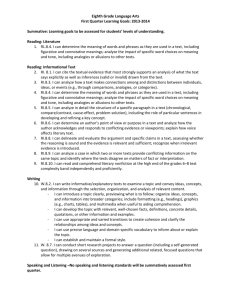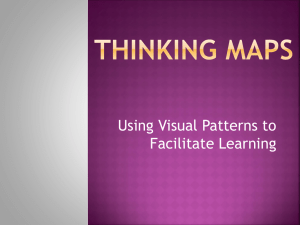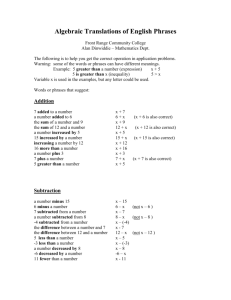College and Career Readiness (CCR) Anchor Reading Standard
advertisement
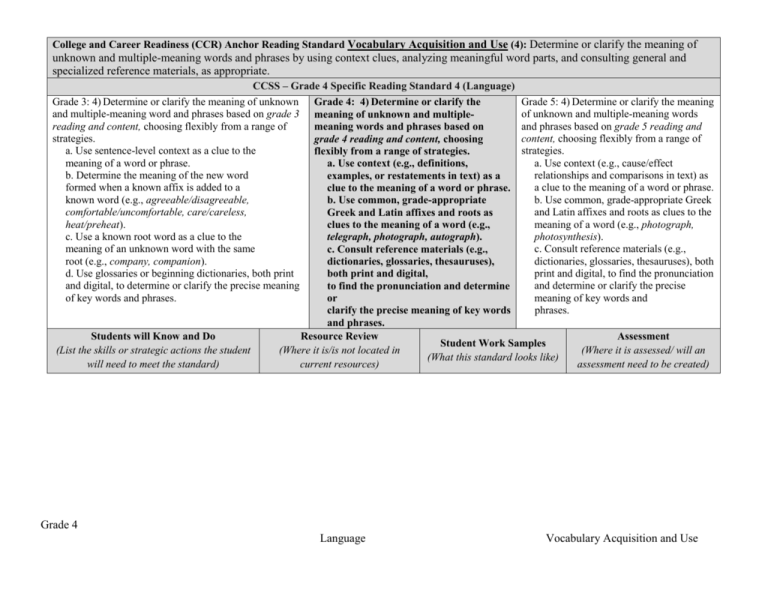
College and Career Readiness (CCR) Anchor Reading Standard Vocabulary Acquisition and Use (4): Determine or clarify the meaning of unknown and multiple-meaning words and phrases by using context clues, analyzing meaningful word parts, and consulting general and specialized reference materials, as appropriate. CCSS – Grade 4 Specific Reading Standard 4 (Language) Grade 3: 4) Determine or clarify the meaning of unknown Grade 4: 4) Determine or clarify the Grade 5: 4) Determine or clarify the meaning and multiple-meaning word and phrases based on grade 3 meaning of unknown and multipleof unknown and multiple-meaning words reading and content, choosing flexibly from a range of and phrases based on grade 5 reading and meaning words and phrases based on strategies. content, choosing flexibly from a range of grade 4 reading and content, choosing a. Use sentence-level context as a clue to the strategies. flexibly from a range of strategies. meaning of a word or phrase. a. Use context (e.g., cause/effect a. Use context (e.g., definitions, b. Determine the meaning of the new word relationships and comparisons in text) as examples, or restatements in text) as a formed when a known affix is added to a a clue to the meaning of a word or phrase. clue to the meaning of a word or phrase. known word (e.g., agreeable/disagreeable, b. Use common, grade-appropriate Greek b. Use common, grade-appropriate comfortable/uncomfortable, care/careless, and Latin affixes and roots as clues to the Greek and Latin affixes and roots as heat/preheat). meaning of a word (e.g., photograph, clues to the meaning of a word (e.g., c. Use a known root word as a clue to the photosynthesis). telegraph, photograph, autograph). meaning of an unknown word with the same c. Consult reference materials (e.g., c. Consult reference materials (e.g., root (e.g., company, companion). dictionaries, glossaries, thesauruses), both dictionaries, glossaries, thesauruses), d. Use glossaries or beginning dictionaries, both print print and digital, to find the pronunciation both print and digital, and digital, to determine or clarify the precise meaning and determine or clarify the precise to find the pronunciation and determine of key words and phrases. meaning of key words and or phrases. clarify the precise meaning of key words and phrases. Students will Know and Do Resource Review Assessment Student Work Samples (List the skills or strategic actions the student (Where it is/is not located in (Where it is assessed/ will an (What this standard looks like) will need to meet the standard) current resources) assessment need to be created) Grade 4 Language Vocabulary Acquisition and Use Determine (3) The meaning of unknown and multiple meaning words Use (3) Context clues Use (3) Common Greek & Latin affixes and roots as clues (grade appropriate) Use (3) Reference materials, both print and digital (pronunciation & meaning) Greek/Latin root examples: telegraph, photograph, autograph College and Career Readiness (CCR) Anchor Reading Standard Vocabulary Acquisition and Use (5): Demonstrate understanding of figurative language, word relationships, and nuances in word meanings. CCSS – Grade 4 Specific Reading Standard 5 (Language) Grade 3: 5) Demonstrate understanding of word Grade 5: 5) Demonstrate understanding of Grade 4: 5) Demonstrate understanding relationships and nuances in word meanings. of figurative language, word relationships, figurative language, word relationships, and a. Distinguish the literal and nonliteral meanings of nuances in word meanings. and nuances in word meanings. words and phrases in context (e.g., take steps). a. Interpret figurative language, a. Explain the meaning of simple b. Identify real-life connections between words including similes and metaphors, in similes and metaphors (e.g., as pretty as and their use (e.g., describe people who are context. a picture) in context. friendly or helpful). b. Recognize and explain the meaning of b. Recognize and explain the meaning c. Distinguish shades of meaning among related words common idioms, adages, and proverbs. of Grade 4 Language Vocabulary Acquisition and Use that describe states of mind or degrees of certainty (e.g., knew, believed, suspected, heard, wondered). Students will Know and Do (List the skills or strategic actions the student will need to meet the standard) Determine (3) c. Use the relationship between particular common idioms, adages, and proverbs. words (e.g., synonyms, antonyms, c. Demonstrate understanding of homographs) to better understand each words by of the words. relating them to their opposites (antonyms) and to words with similar but not identical meanings (synonyms). Resource Review Assessment Student Work Samples (Where it is/is not located in (Where it is assessed/ will an (What this standard looks like) current resources) assessment need to be created) Understanding of figurative language, word relationships, and nuances in word meanings Explain (4) The meaning of similes & metaphors in context Explain (4) The meanings of idioms, adages and proverbs Demonstrate (3) Understanding of words by relating them to antonyms and synonyms Grade 4 Language Vocabulary Acquisition and Use College and Career Readiness (CCR) Anchor Reading Standard Vocabulary Acquisition and Use (6): Acquire and use accurately a range of general academic and domain-specific words and phrases sufficient for reading, writing, speaking, and listening at the college and career readiness level; demonstrate independence in gathering vocabulary knowledge when considering a word or phrase important to comprehension or expression. CCSS – Grade 4 Specific Reading Standard 6 (Language) Grade 3: 6) Acquire and use accurately grade-appropriate Grade 5: 6) Acquire and use accurately Grade 4: 6) Acquire and use accurately conversational, general academic, and domain specific grade-appropriate general academic and grade-appropriate general academic and words and phrases, including those that signal spatial and domain-specific words and phrases, domain-specific words and phrases, temporal relationships (e.g., After dinner that night we went including those that signal precise actions, including those that signal contrast, looking for them). addition, and other logical relationships emotions, or states of being (e.g., quizzed, (e.g., however, although, nevertheless, whined, stammered) and that are basic to a similarly, moreover, in addition). particular topic (e.g., wildlife, conservation, and endangered when discussing animal preservation). Students will Know and Do Resource Review Assessment Student Work Samples (List the skills or strategic actions the student (Where it is/is not located in (Where it is assessed/ will an (What this standard looks like) will need to meet the standard) current resources) assessment need to be created) Aquire and use (6) Accurately gradeappropriate general academic and domain-specific words and phrases Signal precise actions (quizzed) Emotions (whined) States of being Basic to a particular topic (wildlife, conservation) Grade 4 Language Vocabulary Acquisition and Use
